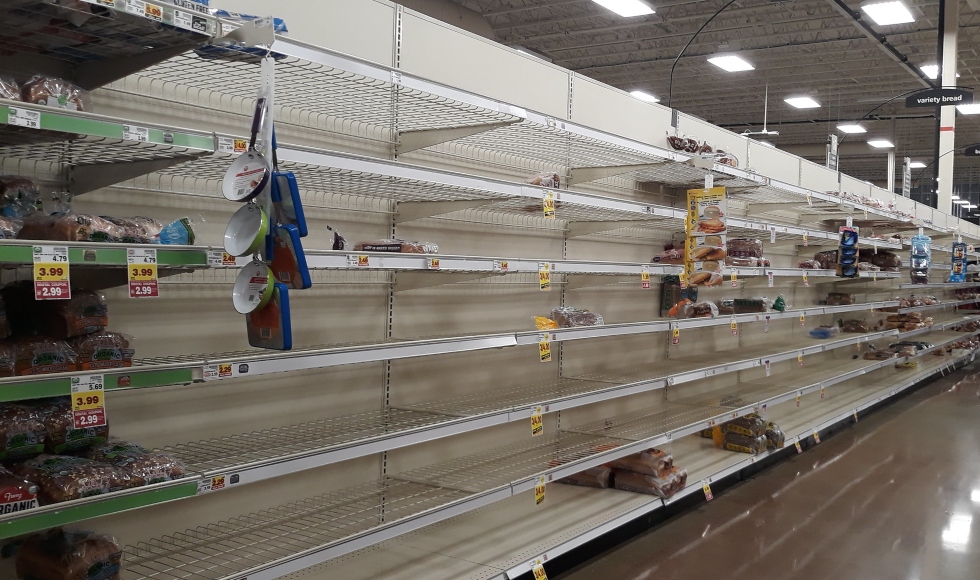Food insecurity is a serious consequence of COVID-19: a geography professor talks about poverty and the pandemic

Photo by Wonderlane/Flickr Creative Commons
BY By Michelle Donovan
May 7, 2020
The COVID-19 pandemic has disrupted food supply chains and put new pressures on grocery stores, hitting society’s most vulnerable. Globally, it has also brought hunger to millions of people, raising fears about the impact of a prolonged pandemic on a much larger scale.
We asked Melanie Bedore, an assistant professor in Geography & Earth Sciences, about the issue. She is teaching a course this fall called Food, Power and Place, which explores the power dynamics around food that manifest in places like kitchens, schools, food banks and grocery stores. The course also explores how food is affected by global events such as COVID-19.
What do you see as the biggest issues regarding food insecurity during this pandemic?
I worry about compromises to people’s physical and mental health related to food insecurity during this pandemic. Food insecurity is about compromises that people are forced to make to either the quality or the quantity of food that they eat. Both these situations compromise a person’s ability to meet their need for a healthy diet.
Moreover, food insecurity also includes the fear of potentially needing to compromise. Worrying about becoming food insecure is a source of stress in people’s lives that ultimately threatens mental and physical health. One in eight households in this country is already food insecure, so we should all be concerned about existing and newly food insecure households.
Globally, organizations like the World Food Programme (WFP) are concerned about how this pandemic may interrupt food supply chains in less developed places. What’s even more disturbing is a range of other issues happening that are even more disastrous: Violent conflicts bring about food insecurity. Locust swarms in Eastern Africa are having a disastrous impact on agriculture, which ultimately threatens local food supply and supply chains.
How are society’s vulnerable populations even more at risk right now?
The pandemic is ultimately compounding existing food security problems in much of the world. 100 million people globally already rely on international food aid and emergency relief programmes for nearly all the food that eat. The WFP reports that 821 million people still go to bed hungry each night.
This pandemic could create further vulnerability if governments decide to hoard their food supplies and wealth, stop their humanitarian generosity or close off their borders and supply chains for fear of spreading the coronavirus. These actions could be disastrous, leading to millions of deaths globally.
Locally, the vulnerable people in Canadian society and in our cities especially are made more vulnerable for a few reasons. In Canada, food is largely a private matter: as a society, we’ve decided that food production, distribution and retailing are best done by private, for-profit actors. Food retailers must work exceptionally hard to compete and innovate in a fiercely competitive industry. Profit margins are notoriously small, and retailers must struggle not to lose market share to their competitors.
In the last several decades, retailers have engaged in many cost-saving measures that ultimately can make grocery shopping more of a challenge for society’s most vulnerable people: consolidating many smaller grocery stores into a few very large stores is a good cost-saving measure, but people without personal vehicles may need to travel a longer distance to access food. They may need to navigate multiple buses routes and/or expensive taxi rides to do their grocery shopping and may struggle getting groceries back home.
This is especially concerning in smaller or cash-strapped towns where public transit is already modest at best.
Is there anything that can be done in the food supply chain to help them? What needs to change?
Fortunately, the world has remained a very generous place over last few months. Nations have increased their contributions to emergency food programmes and funding to increase local resilience in countries where food insecurity is high
Locally, Hamiltonians’ generosity has been so wonderful to see. Civic groups and ad hoc groups of citizens have come together to collect money, food donations and other supplies for their neighbours in need. Food banks have continued to operate while other spaces like libraries and schools have been repurposed so that charitable food chains can continue to reach people who need them.
Grocery shopping and delivery services are also proliferating in some interesting ways. Retailers’ move to online ordering and delivery will provide some relief but we must still remember that not everyone is able to making online purchases. Seniors and the very poor may still not be well served by this model.
People have also been incredibly helpful by running errands such as grocery shopping for their older or less mobile neighbourhoods during this time of social distancing, so it’s encouraging to see a flourishing of generous spirit at this difficult time.
What do you want people to be especially aware of regarding food insecurity?
Food insecurity is often beyond people’s own control. We live in a politically dangerous time where the easiest thing to do is to blame individuals for getting themselves into poverty or failing to get themselves out of poverty.
But food insecurity is about so much more: it is affected by the withdrawal of government social supports and safety nets, minimum wage laws, retailers’ decisions about what is profitable or not, global politics and health crises, and the flow of global food supplies in a way that is fair and just for food producers and labourers throughout the world.
Poverty that leads to food insecurity is complex and cannot be explained away by blaming individuals. It is a compassionate and political act to remember this and to remember the power that we as citizens in a democracy have to create a society where no one worries about having enough food.


